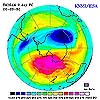| . |  |
. |
Stockholm - Sep 01, 2003 The core of the earth doesn't look the way it was expected to. Scientists at the Royal Institute of Technology in Stockholm, Sweden, KTH, can now show that iron, under extremely high pressure, such as that found in the inner earth, takes on unexpected properties, and this can be of importance in understanding the movements of the earth, such as, earthquakes. The results are being presented in the new issue of the British scientific journal Nature. The core of the earth consists almost exclusively of iron. The iron atoms in a piece of iron, in room temperature, are packed according to a certain structure, in this case called body centered cubic or bcc. This means the atoms are relatively sparsely packed. When the piece of iron is exposed to greater pressure, the iron atoms place themselves differently in relation to each other and take on another kind of structure, so-called hexagonal close packed, or hcp. The become more densely packed, which seems natural, and it has long been assumed that the higher the temperature and pressure iron is exposed to, the more stable the hpc structure will be. Researchers from the department KTH Materials Science maintain, however, that this not the case. With the help of computer simulations, they have now shown that iron, unexpectedly, reverts to bcc structure at extreme temperatures and pressures. Exactly why this occurs is the next question for science to tackle. Research into the inner parts of the earth has enjoyed a great boom over the last few years, largely owing to the fact that equipment has not been available until today to simulate the conditions down there. It is pure research, and the discoveries are thus far difficult to evaluate in terms of money or practical applications, but it might be possible to use increased knowledge of the construction of the earth in geology to understand the significance of the core of the earth in earthquakes or volcano eruptions. Related Links Swedish Research Council Stockholm SpaceDaily Search SpaceDaily Subscribe To SpaceDaily Express
 Washington - Sep 01, 2003
Washington - Sep 01, 2003Researchers have discovered that total bromine in the lower atmosphere has been decreasing since 1998 and is now more than five percent below the peak reached that year. Bromine is one of the most active destroyers of the stratospheric ozone layer, which forms an invisible shield around the Earth, protecting it from the biologically damaging ultraviolet rays of the Sun. |
|
| The content herein, unless otherwise known to be public domain, are Copyright 1995-2006 - SpaceDaily.AFP and UPI Wire Stories are copyright Agence France-Presse and United Press International. ESA PortalReports are copyright European Space Agency. All NASA sourced material is public domain. Additionalcopyrights may apply in whole or part to other bona fide parties. Advertising does not imply endorsement,agreement or approval of any opinions, statements or information provided by SpaceDaily on any Web page published or hosted by SpaceDaily. Privacy Statement |